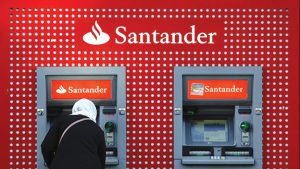Bloomberg
Banco Santander SA pledged to increase profitability and shareholder payouts as rising interest rates in key markets from the Americas to Europe are set to boost income from lending at the Spanish retail banking behemoth.
The bank also signalled it has done strengthening capital buffers after rebounding from steep losses two years ago at the onset of the pandemic. In the long run, Santander said it aims to boost shareholder payouts beyond the current 40% of underlying profit. This is a modal window. The media could not be loaded, either because the server or network failed or because the format is not supported.
The results cap a year of recovery for Spain’s biggest lender, which booked massive charges when the pandemic first hit. While the retail-focused bank hasn’t benefited as much as some rivals from the trading and dealmaking rally, it stands to gain as economies worldwide return to growth and interest rates rise in markets from the US to the UK
“We are positioned for higher rates,†Chairman Ana Botin said in an interview with Bloomberg TV on Wednesday, after reporting net income for the fourth quarter that beat analysts’ estimates. “We believe that’s going to happen across all our
markets sooner or later.â€
Shares of Santander swung between gains and losses, falling 1.1% in Madrid after gaining 0.8% earlier. They have risen 24% over the past year, trailing the 48% increase in an index of European lenders.
Benjie Creelan-Sandford, an analyst at Jefferies International, pointed to operational weakness in UK where earnings were boosted by a release of provisions while fee income and net interest income dipped from the previous quarter.
For the bank as a whole, earnings were boosted by a 750 million-euro write-back of provisions put aside in 2020 to cover pandemic losses.
Santander said it would now focus on maintaining a key measure of financial strength — the so-called CET1 ratio — at around 12%. The lender for years had been operating with a lower capital level, arguing that as a retail business, it’s not exposed to the same risks as the large investment banks.
With the bank effectively setting a limit on how much it will keep building up capital buffers, it said it aspires to raise shareholder remuneration in the longer term, with around half through share buybacks and a growing cash dividend.
“It’s been a pivotal year for us on capital,†Botin said in the interview. A capital ratio at 12% “is not just enough for us to continue growing, it’s enough to increase returns to shareholders.â€
The lender, in a presentation, also set new medium-term targets for profitability and cost efficiency, aiming for an underlying return on tangible equity of 15% and a cost to income ratio of about 40%. Those metrics last year stood at 12.7% and 46.2%, respectively.
“This was a good set of numbers,†said Daragh Quinn, an analyst at KBW. “I think the debate about them being undercapitalized has moved on a bit.â€
 The Gulf Time Newspaper One of the finest business newspapers in the UAE brought to you by our professional writers and editors.
The Gulf Time Newspaper One of the finest business newspapers in the UAE brought to you by our professional writers and editors.
